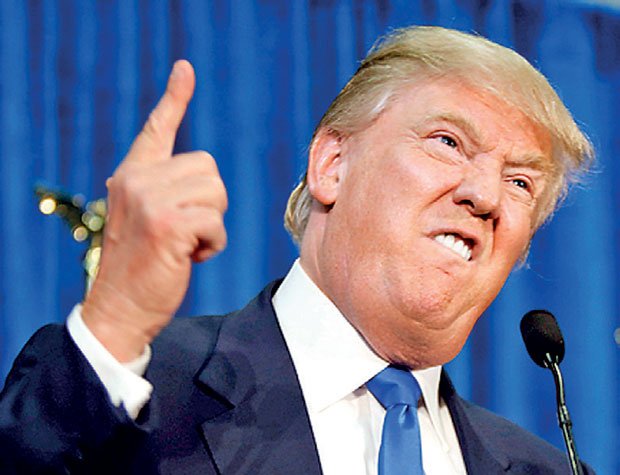26 Jan 2017 - {{hitsCtrl.values.hits}}

 The incoming Trump administration may promise a rewriting of the US-backed liberal world order in place since the end of World War II. Based on campaign promises and post-election statements, Trump promises either taking on a highly aggressive outward stance or turning the US strategically inward as it reverses the US participation in international affairs.
The incoming Trump administration may promise a rewriting of the US-backed liberal world order in place since the end of World War II. Based on campaign promises and post-election statements, Trump promises either taking on a highly aggressive outward stance or turning the US strategically inward as it reverses the US participation in international affairs.
During the election campaign Trump took highly protectionist positions on trade and promised to name China a currency manipulator on whose goods his administration would impose very high tariffs. Such policies depart from the US-sponsored liberal economic order that has been the bedrock of global economic prosperity since World War II.
Based around the Bretton Woods institutions and the US dollar, the US-led economic order was a commitment to economic development, liberalisation and stability. This came from a broad post-war consensus that the absence of economic coordination, beggar-thy-neighbour policies and the lack of an international lender of last resort exacerbated and prolonged the effects of the Great Depression. Moreover, proponents of this post-war consensus saw such conditions as creating fertile ground for the rise of fascism and, ultimately, World War II.
An outwardly-oriented, internationalist US created the opportunities for the reconstruction of Europe and Japan and the economic rise of Hong Kong, South Korea, Singapore, Taiwan and China from the 1970s. Southeast Asian states plugged into the US-backed international economic order and Indonesia, Malaysia and Thailand moved into the ranks of middle-income economies.
A protectionist US that is prepared to engage in trade and currency wars effectively kicks the legs out from the liberal international economic order. And despite the enthusiasm surrounding alternative trade regimes such as the Regional Comprehensive Economic Partnership, Free Trade Area of the Asia-Pacific, ASEAN–China Free Trade Agreement and institutions like the Asian Infrastructure Investment Bank, the BRICs Bank or the European Central Bank, there are not yet any realistic alternatives to the Bretton Woods institutions and the liberal economic order.
The Trump administration may also upend the US’ role as provider of international security, a key global public good. For all of the US’ belligerence and involvement in conflicts ranging from Korea to Vietnam, Central Asia and the Middle East, the forward US military presence and US alliance system helps to bolster security worldwide — even if for self-interested reasons.
With the promise of US-led regional stability, countries in Asia and elsewhere could expect stability and spend less than they otherwise might on defence, enabling governments to invest more on domestic social programmes and the economy. The freedom and safety of navigation that the US Navy provides, Washington’s non-ratification of the United Nations Convention on the Law of the Sea notwithstanding, likewise makes the world’s seas and oceans safer for commerce.
President-elect Trump and his advisors have articulated two broad foreign policy approaches. One is a more isolationist US whose forward presence rests on the ability of partners to pay for cooperation with it. Despite the rise of countries like China and India, the resurgence of Russia and the capabilities of the European Union, there remains no actor or group of actors that could be an alternate provider of stability globally. These actors may be able to secure their own immediate regions, but gaps in the provision of security and stability are likely to emerge between regional orders, potentially resulting in intensifying rivalry and competition.
Another potential US approach to foreign and security policy under the Trump administration is one that is less restrained and more coercive, especially toward rivals and threats. Indeed, some of Trump’s advisors have been talking about expanding the US Navy and taking a tougher position on China.
Trump has himself discussed a more aggressive policy toward the so-called Islamic State and other terrorist organisations, which includes policies that target Muslims. Such directions in the US foreign and security policy may lead to more confrontation and escalating tensions across the world. Even if this does not result in major conflicts, regions where the US military is actively taking robust action are likely to experience greater insecurity. Such instability may well spread across borders and maritime boundaries as regional states and other actors respond to the US military operations and diplomatic pressure.
But the Trump administration might even waver between these two approaches as hawkish advisors on Asia and China disagree with more isolationist and protectionist economic and domestic political advisors. The resulting uncertainty would almost certainly spook investors and businesses. Arms races and instability may become more prominent as states take to defending themselves in the absence of a credible security umbrella and the proliferation of nuclear weapons in Asia and Europe may become a reality as states pursue robust, independent defence postures.
There is a possibility that Trump administration policy will converge toward more comfortable, longstanding norms after an initial period of tumult. But if the incoming administration’s handling of the transition is any indication, there may be little reason for such optimism. Governments in Asia and elsewhere would do well to focus actively on ways to mitigate the uncertain and potentially dangerous results of erratic or irresponsible US international behaviour as early as possible.
(Ja Ian Chong is Assistant Professor of political science at the National University of Singapore)
09 Jan 2025 3 hours ago
09 Jan 2025 5 hours ago
09 Jan 2025 7 hours ago
09 Jan 2025 8 hours ago
09 Jan 2025 8 hours ago